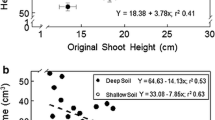Summary
Eucalyptus species have a great capacity for regeneration after harvest, which allows a second rotation as a coppice crop. The decision whether to manage the next rotation as a coppice crop or to replant depends on the expected economic result of each alternative. The problem that foresters face is the difficulty of predicting the productivity in the next rotation, which will depend largely on the percentage of stumps that resprout. Therefore, the objectives of this work were: (i) to identify the preharvest variables that influence stump regrowth and (ii) to develop a model for predicting the probability of stump regrowth in commercial plantations of Eucalyptus globulus in Uruguay based on pre-harvest information. Thirty-three plots were established in commercial plantations, in which silvicultural management, growth and health status before harvest were recorded, as well as the number of stumps that sprouted after harvest. Significant differences were found in the percentage of resprout for the following variables: genetic material, type of harvest machine, proportion of trees with DBH > 14 cm, proportion of trees with bark cankers, proportion of trees with epicormic shoots, and proportion of trees with apical death. However, the logistic regression model adjusted to predict the probability of regrowth only included as explanatory variables the genetic material, the type of harvesting machine, the proportion of trees with DBH > 14 cm, and the proportion of trees with bark cankers. The use of this model will allow managers of E. globulus plantations to make more informed decisions for the next rotation.




Similar content being viewed by others
References
Akaike H (1974) A new look at the statistical model identification. IEEE T Automat Contr 19(6):716–723
Alonso R, Lupo S, Martínez S, Tiscornia S, Bettucci L (2012) Development of sprouted stumps of Eucalyptus globulus and E. maidenii in Uruguay. Aust Forestry 75:130–134
Balmelli G, Resquín F (2005) Efecto de enfermedades del fuste en Eucalyptus globulus. Forestal 27:9–14
Camargo F, Silva C, Stape JL (1997) Resultados experimentais da fase de emissão de brotação em Eucalyptus manejado por talhadia. Serie Técnica IPEF 11(30):115–122
Castaño JP, Giménez A, Ceroni M, Furest J, Aunchayna R (2011) Caracterización agroclimática del Uruguay 1980–2009. Serie Técnica INIA 193
FAO (1981) El eucalipto en la repoblación forestal. FAO: Estudios de silvicultura y productos forestales N° 11. Roma, Italia
Giambruno F, Lopez S (2010) Medición de activos forestales en Uruguay. Universidad de la República, Facultad de Ciencias Económicas y Administración. Montevideo, Uruguay
Hamilton L (2005) Managing Eucalyptus coppice. Plantation Guidelines 21. Department of Primary Industries, Victoria. http://www.nla.gov.au/nla.arc-61272. Accessed 5 June 2020
Higa R, Sturion JA (1997) Capacidade de brotação em subgêneros e espécies de Eucalyptus. Serie Técnica IPEF 11(30):23–30
Hosmer D, Lemeshow S (2000) Applied Logistic Regression. Wiley Series in Probability and Statistics, 2ºedición, Canada
Klein J, Bortolas E, Francisco de Assis T, Perrando E (1997) Fatores operacionais que afetam a regeneração do Eucalyptus manejado por talhadia. Serie Técnica IPEF 11(30):95–104
Little KM, Gardner R (2003) Coppicing ability of 20 Eucalyptus species grown at two high-altitude sites in South Africa. Can J Forest Res 33:181–189
Little KM, MacLennan L (2001) Coppicing potential of Eucalyptus nitens: results of a field survey. ICFR innovations 2001/02. Institute for Commercial Forestry Research, Pietermaritzburg
Louviere JJ, Hensher AD, Swait DJ (2000) Stated choice methods. Cambridge University Press, New York
Pando V, San Martín R (2004) Regresión logística multinomial. Cuadernos de la Sociedad Española de Ciencias Forestales (18). https://doi.org/10.31167/csef.v0i18.9478
Prado JA, Bañados JC, Bello DA (1990) Antecedentes sobre la capacidad de retoñación de algunas especies de género Eucalyptus en Chile. Ciencia e Investigación Forestal 4:183-190. https://doi.org/10.52904/0718-4646.1990.139
Schiattino I, Silva C (2008) Árboles de Clasificación y Regresión: Modelos Cart. Ciencia y Trabajo 10:161–166
Schönau APG (1991) Growth, yield and timber density of short rotation coppice stands of Eucalyptus grandis. S Afr Forestry J 156:12–22.
Stape JL (1997) Planejamento global e normatização de procedimentos operacionais da talhadia simples em Eucalyptus. Serie Técnica IPEF 11(30):51–62
Toval G (2010) Calidad de la madera de Eucalyptus globulus como materia prima para la industria pastero-papelera. Boletín del CIDEU (8–9):5–14
Whittock SP, Apiolaza LA, Kelly CM, Potts BM (2003) Genetic control of coppice and lignotuber development in Eucalyptus globulus. Aust J Bot 51:57–67
Acknowledgements
We are grateful to Redalco S.A, Iberpapel and Forestal Atlántico Sur for allowing us access to their plantations and for the logistic support provided. The study was funded by a scholarship awarded by INIA (National Institute of Agricultural Research) to the first author.
Author information
Authors and Affiliations
Contributions
The conception and design of the study was carried out by Gustavo Balmelli. Material preparation and data collection were performed by Gustavo Balmelli and Pilar Gasparri. All authors contributed to the data analysis. Pilar Gasparri wrote the first draft, and all authors commented the manuscript. All authors read and approved the final version of this manuscript.
Corresponding author
Ethics declarations
Competing interests
The authors have no competing interests to declare that are relevant to the content of this article.
Additional information
Publisher’s Note
Springer Nature remains neutral with regard to jurisdictional claims in published maps and institutional affiliations.
Rights and permissions
Springer Nature or its licensor (e.g. a society or other partner) holds exclusive rights to this article under a publishing agreement with the author(s) or other rightsholder(s); author self-archiving of the accepted manuscript version of this article is solely governed by the terms of such publishing agreement and applicable law.
About this article
Cite this article
Gasparri, P., Hirigoyen, A., Rachid-Casnati, C. et al. Predictive model of stump regrowth in Eucalyptus globulus based on pre-harvest information. New Forests 55, 567–579 (2024). https://doi.org/10.1007/s11056-023-09993-7
Received:
Accepted:
Published:
Issue Date:
DOI: https://doi.org/10.1007/s11056-023-09993-7




